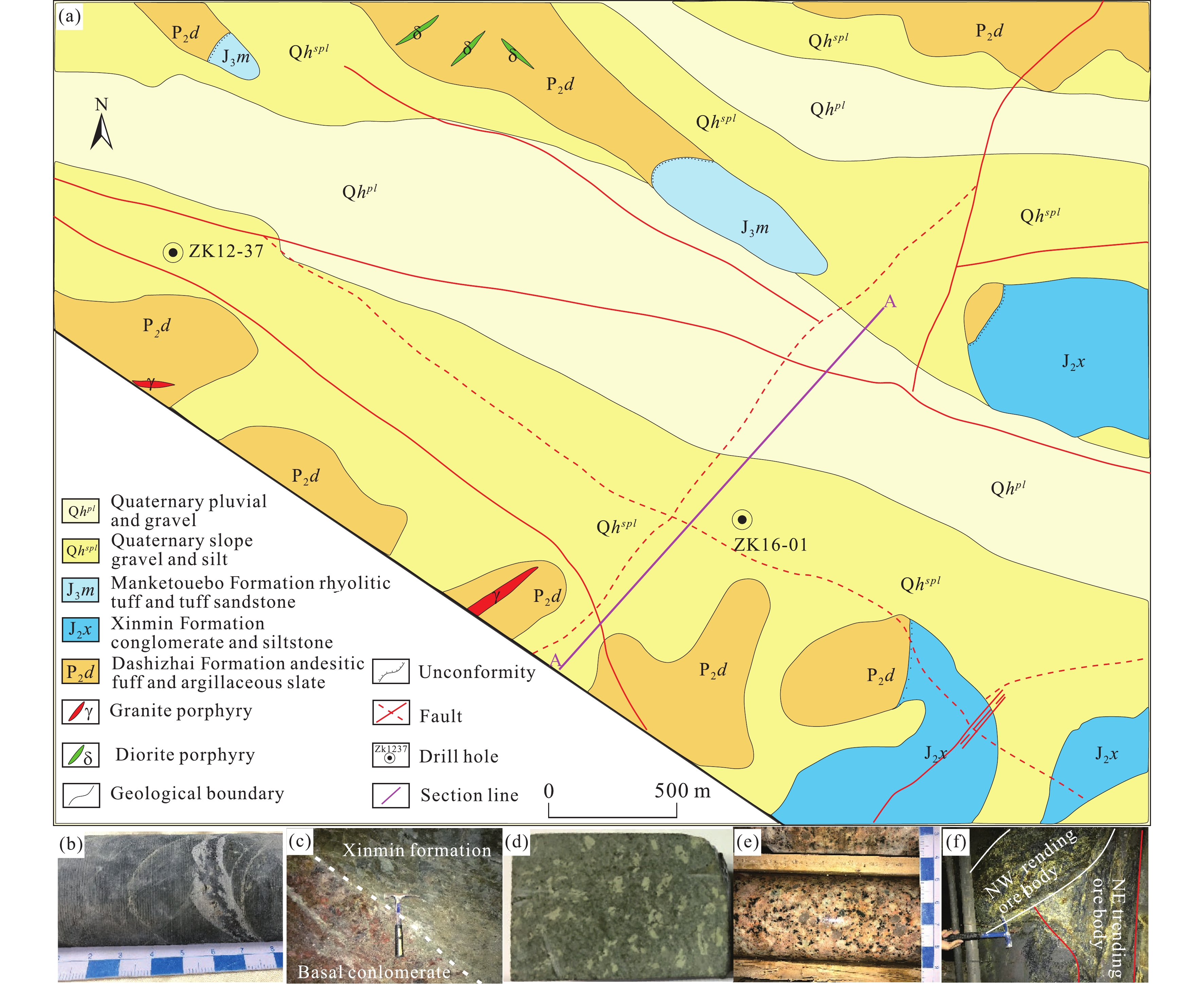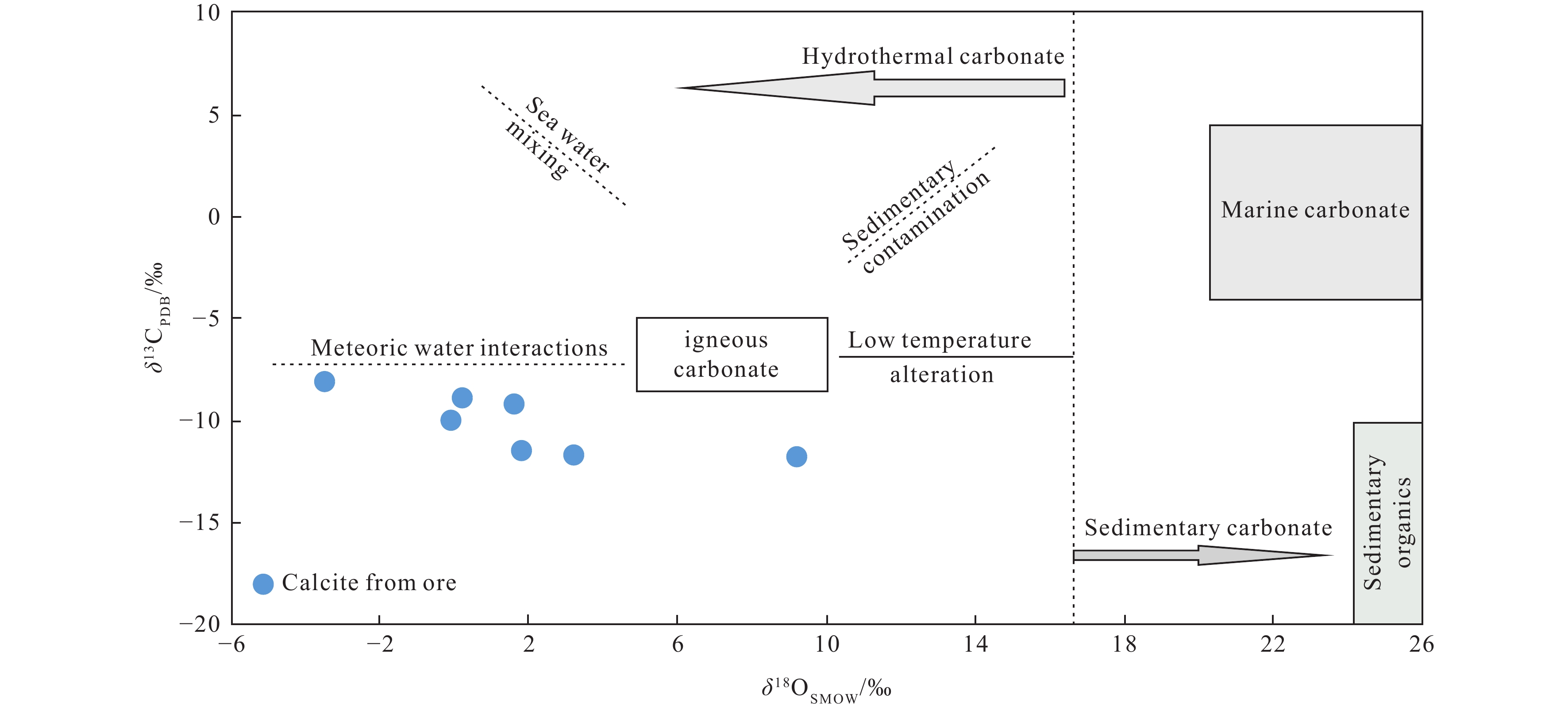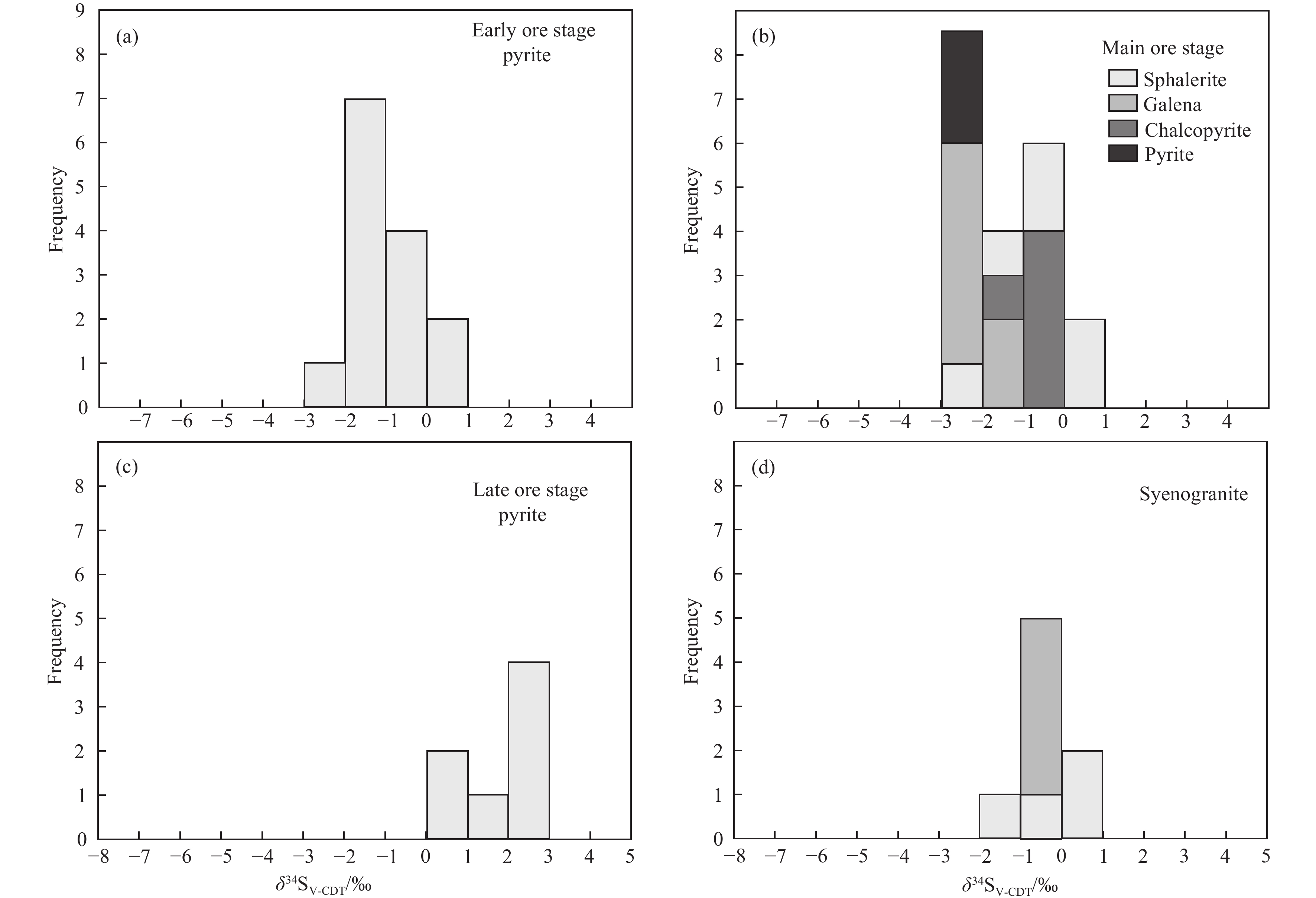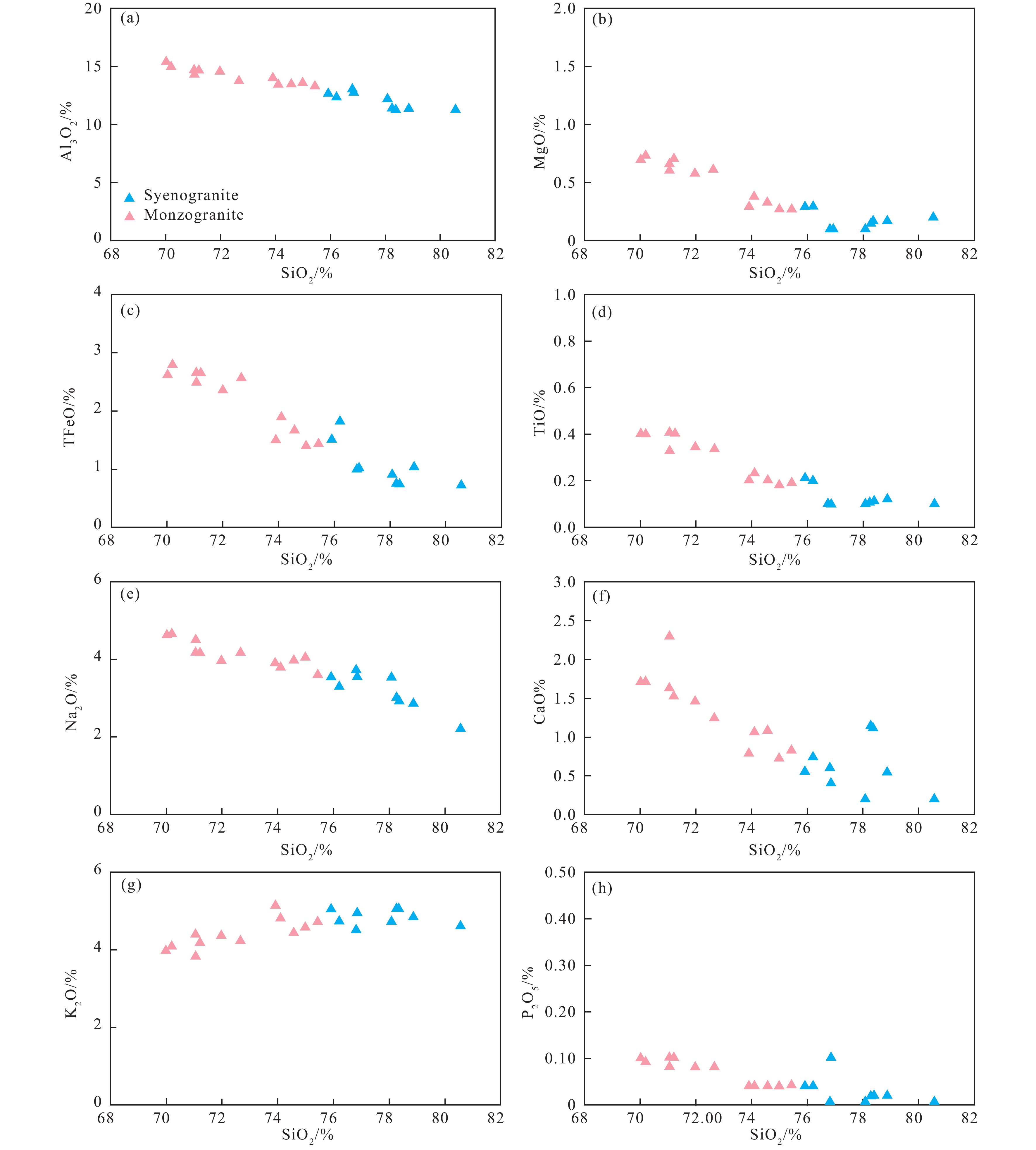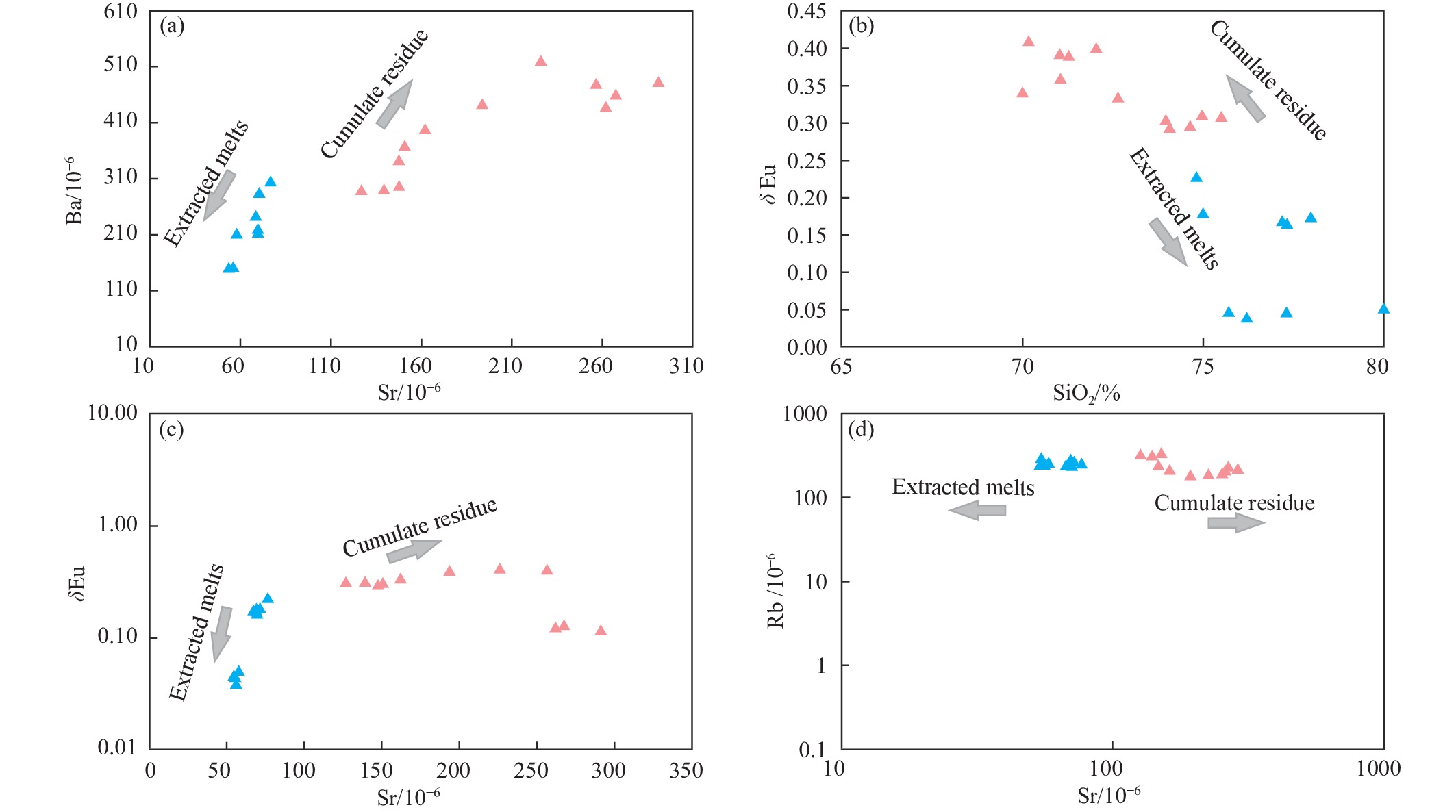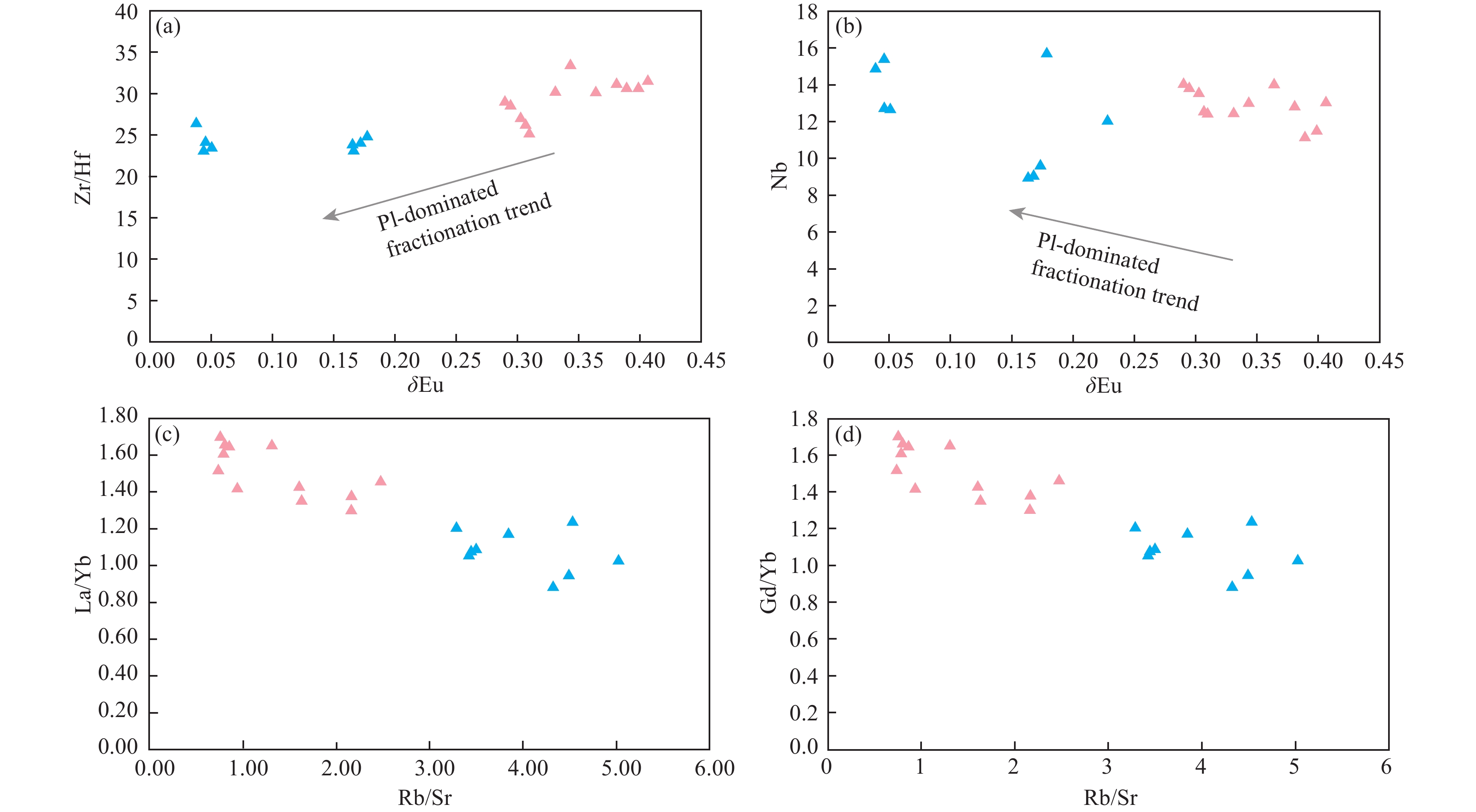| Citation: | Meng Dai, Guang-sheng Yan, Yong-sheng Li, Wen-bin Jia, Fan-yu Qi, Xing Ju, 2023. Melt extraction and mineralization: A case study from the Shuangjianzishan supergiant Ag-Pb-Zn deposit (208 Mt), Inner Mongolia, NE China, China Geology, 6, 623-645. doi: 10.31035/cg2022044 |
Melt extraction and mineralization: A case study from the Shuangjianzishan supergiant Ag-Pb-Zn deposit (208 Mt), Inner Mongolia, NE China
-
Abstract
The supergiant Shuangjianzishan (SJZ) Ag-Pb-Zn deposit is in the southern segment of the Great Hinggan Range (SGHR), northeast China. Previous studies suggest the ore-forming material and fluid originated from the magmatic system, and the mineralization age was consistent with the diagenetic age. However, the relationship between granitic magmatism and mineralization is still unclear in the SJZ. In this study, C-H-O-He-Ar and in-situ S-Pb isotope analyses were conducted to determine the sources of ore-forming fluids and metals, which were combined with geochemistry data of SJZ granitoids from previous studies to constrain the relationship between the magmatism and the mineralization. The C-H-O-He-Ar-S-Pb isotopic compositions suggested the SJZ ore-forming material and fluids were derived from a magmatic source, which has mixed a small amount of mantle-derived materials. In addition, the disseminated sulfide from the syenogranite has comparable S-Pb isotopic composition with the sulfide minerals from ore veins, suggesting that the generation of the SJZ ore-forming fluids has a close relationship with the syenogranite magmatism. Combining with the geochemical characters of the syenogranite, the authors proposed that the mantle-derived fingerprint of the SJZ ore-forming fluid might be caused by the parent magma of the syenogranite, which was derived from partial melting of the juvenile lower crust, and underwent the residual melts segregated from a crystal mush in the shallow magma reservoir. The extraction of the syenogranite parent magma further concentrated the fertilized fluids, which was crucial to mineralization of the SJZ Ag-Pb-Zn deposit.
-

-
References
Andrew A, Godwin CI, Sinclair AJ. 1984. Mixing line isochrons: A new interpretation of galena lead isotope data from Southeastern British Columbia. Economic Geology, 79, 919–932. doi: 10.2113/gsecongeo.79.5.919. Baker T, Achterberg VE, Ryan GC, Lang RJ. 2004. Composition and evolution of ore fluids in a magmatic-hydrothermal skarn deposit. Geological Society of America, 32, 117–120. Bao ZA, Yuan WT, Yuan HL, Liu X, Chen KY, Zong CL. 2016a. Non-matrix-matched determination of lead isotope ratios in ancient bronze artifacts by femtosecond laser ablation multi-collector inductively coupled plasma mass spectrometry. International Journal of Mass Spectrometry, 402, 12–19. doi: 10.1016/j.ijms.2016.03.001. Bao ZA, Yuan HL, Zong CL, Liu Y, Chen KY, Zhang YL. 2016b. simultaneous determination of trace elements and lead isotopes in fused silicate rock powders using a boron nitride vessel and fsLA-(MC)-ICP-MS. Journal of Analytical Atomic Spectrometry, 31, 1012–1022. doi: 10.1039/C5JA00410A. Barton PB, Bethke PM. 1987. Chalcopyrite disease in sphalerite: Pathology and epidemiology. American Mineralogist, 72 (5‒6), 451‒467. Beane R, Wiebe RA. 2012. Origin of quartz clusters in Vinalhaven granite and porphyry, coastal Maine. Contributions to Mineralogy and Petrology, 163(6), 1069–1082. doi: 10.1007/s00410-011-0717-1. Cai HA, Yang ZA, Yin ZW, Xiao WJ, Li YY. 2021. Metallogenic regularity and exploration direction of Shuangjianzishan Ag-Pb-Zn deposit in Inner Mongolia, China. Mineral Exploration, 7(12), 1576–1581 (in Chinese with English abstract). Clayton RN, Mayeda TK. 1963. The use of bromine pentafluoride in the extraction of oxygen from oxides and silicates for isotopic analysis. Geochimica et Cosmochimica Acta, 27, 43–52. doi: 10.1016/0016-7037(63)90071-1. Chen L, Chen KY, Bao ZA, Liang P, Sun TT, Yuan HL. 2016. Preparation of standards for in situ sulfur isotope measurement in sulfides using femtosecond laser ablation MC-ICP-MS. Journal of Analytical Atomic Spectrometry, 32, 107–116. doi: 10.1039/c6ja00270f. Chiaradia M, Konopelko D, Seltmann R, Cliff AR. 2006. Lead isotope variations across terrane boundaries of the Tien Shan and Chinese Altay. Mineralium Deposita, 41(5), 411–428. doi: 10.1007/s00126-006-0070-x. Clark I, Fritz P. 1997. Environmental Isotopes in Hydrogeology. New York, Lewis Publishers, 328. Cook NJ, Ciobanu CL, Pring A, Skinner W, Shimizu M, Danyushevsky L, Saini-Eidukat B, Melcher F. 2009. Trace and minor elements in sphalerite: A LA-ICP-MS study. Geochimica et Cosmochimica Acta, 73, 4761–4791. doi: 10.1016/j.gca.2009.05.045. Cooke DR, Deyell CL, Waters PJ, Gonzales RI, Zaw K. 2011. Giant porphyry deposits: Characteristics, distribution, and tectonic controls. Economic Geology, 100(5), 801–818. doi: 10.2113/gsecongeo.100.5.801. Craig H. 1961. Isotopic variations in meteoric waters. Science, 133(3465), 702–1703. Dai M, Yan GS, Liu C, Deng JF, Li YS, Jia WB, Lai CK. 2019. Southward subduction of the Mongolia–Okhostk Ocean: Insights from Early–Middle Triassic intrusive rocks from the Jiawula–Tsagenbulagen area in NE China. Geological Journal, 55(1), 1–27. doi: 10.1002/gj.3435. Dai M, Yan GS, Li YS, Gong, FY, Jia WB. 2022. The origin of microgranular enclaves in the Early Cretaceous Shuangjianzishan granites in southern Great Hinggan Range, NE China. Geological Journal. doi: 10.1002/gj.4432. Doe BR, Zartman RE. 1979. Plumbotectonics, the phanerozoic. Geochemistry of Hydrothermal Ore deposits. New York, Wiley Interscience Publications, 22–70. Eldridge CS, Bourcier WL, Ohmoto H, Barnes HL. 1988. Hydrothermal inoculation and incubation of the chalcopyrite disease in sphalerite. Economic Geology, 83(5), 978–989. doi: 10.2113/gsecongeo.83.5.978. Jahn BM, Wu F, Chen B. 2000. Granitoids of the Central Asian orogenic belt and continental growth in the Phanerozoic. Geological Society of America, Special Papers, 350, 181–193. Jiang B, Wang DH, Chen YC, Zhang T, Pu XL, Ma WW, Wang Y, Wu G, Wu LW, Zhang T, Li XJ, Yan J, Zuo YS, Sun HJ, Li ZY. 2022. Classification, metallogenesis and exploration of silver deposits in Daxing’anling of Inner Mongolia and its adjacent areas. China Geology. doi: 10.31035/cg2022005. Jiang SH, Nie FJ, Liu YF, Yun, F. 2010. Sulfur and lead isotopic compositions of Bairendaba and Weilasituo silver-polymetallic deposits, Inner Mongolia. Mineral Deposits, 29(1), 101–112 (in Chinese with English abstract). Jiang SH, Nie FJ, Bai DM, Niu SY, Wang BD, Liu YF, Liu Y. 2011a. Study on the lead isotopic features of the Baiyinnuoer Pb-Zn deposit in Inner Mongolia. Journal of Earch Sciences and Environment, 33, 230–238 (in Chinese with English abstract). Jiang SH, Nie FJ, Bai DM, Liu YF, Liu Y. 2011b. Geochronology evidence for Indosinian mineralization in Baiyinnuoer Pb-Zn deposit of Inner Mongolia. Mineral Deposits, 30, 787–798 (in Chinese with English abstract). Jiang SH, Chen CL, Bagas L, Liu Y, Han N, Kang H, Wang ZH. 2017. Two mineralization events in the Baiyinnuoer Zn-Pb deposit in Inner Mongolia, China: Evidence from field observations, S-Pb isotopic compositions and U-Pb zircon ages. Journal of Asian Earth Sciences, 144, 339–367. doi: 10.1016/j.jseaes.2016.12.042. Kendrick MA, Burgess, R, Pattrick, RAD, Turner, G. 2001. Fluid inclusion noble gas and halogen evidence on the origin of Cu-porphyry mineralizing fluids. Geochimica et Cosmochimica Acta, 65, 2651–2668. doi: 10.1016/S0016-7037(01)00618-4. Kendrick MA, Burnard P. 2013. Noble gases and halogens in fluid inclusions: A journey through the Earth’s Crust. The Noble Gases as Geochemical Tracers, 319–369. Kuang YS., Zheng GR, Lu MJ, Liu YL, Zhang SJ, Li Y, Chen WJ. 2014. Basic characteristics of Shuangjianzishan sliver polymetallic deposit in Chifeng City, Inner Mongolia. Mineral Deposits, 33(4), 847–856 (in Chinese with English abstract). Li JF, Wang KY, Quan HY, Sun FY, Zhao LS, Zhang XB. 2016. Discussion on the magmatic evolution sequence and metallogenic geodynamical setting background Hongling Pb-Zn deposit in the southern Da Xing’an Mountains. Acta Petrologica Sinica, 32(5), 1529–1542. Li JY, Qian Y, Tekoumc L, Zhao CJ, Sun JL, Zheng T, Sun FY, Shen YJ. 2021. Petrogenesis of Jurassic Granitoids on Liaodong Peninsula, Northeast China: Constraints on the Evolution of the Mongol-Okhotsk and Pacific Tectonic Regimes. Journal of Earth Science, 32(1), 127–143. doi: 10.1007/s12583-020-1372-0. Liu C, Deng JF, Xu LQ, Zhang Y, Zhao HD, Kong WQ, Li N, Luo ZH, Bai LB, Zhao, GC, Su SG. 2011. A preliminary frame of magma- tectonic-Mo metallogenic events of Mesozoic era in Da Hingganmountains and Xiao Hinggan mountains areas. Earth Science Fronters, 18, 166–178 (in Chinese with English abstract). Liu HB, Jin GS, LI JJ, Han J, Zhang JF, Zhang J, Zhong FW, Guo DQ. 2013. Determination of stable isotope composition in uranium geological samples. World Nuclear Geoscience, 30(3), 174–179 (in Chinese with English abstract). Liu YF, Jiang S, Bagas L. 2016. The genesis of metal zonation in theWeilasituo and Bairendaba Ag-Zn-Pb-Cu-(Sn-W) deposits in the shallowpart of a porphyry Sn-W-Rb system, Inner Mongolia, China. Ore Geology Review, 75, 150–173. doi: 10.1016/j.oregeorev.2015.12.006. Liu YF, Jiang S, Bagas L, Han N, Chen CL, Kang H. 2017. Isotopic (C-O-S) geochemistry and Re-Os geochronology of the Haobugao Zn-Fe deposit in Inner Mongolia, NE China. Ore Geology Review, 82, 130–147. doi: 10.1016/j.oregeorev.2016.11.024. Liu LJ, Zhou, TF, Zhang DY, Yuan F, Liu G. X, Zhao ZC, Sun JD, White N. 2018. S isotopic geochemistry, zircon and cassiterite U-Pb geochronology of the Haobugao Sn polymetallic deposit, southern Great Xing’an Range, NE China. Ore Geology Review, 93, 168–180. doi: 10.1016/j.oregeorev.2017.12.008. Luo ZH, Lu XX, Xu JY, Liu C and Li DD. 2010. Petrographic indicators of the ore-bearing intrusions. Acta Petrologica Sinica, 26(8): 2247–2254 (in Chinese with English abstrac). doi: CNKI:SUN:YSXB.0.2010-08-003. Luo ZH, Lu XX, Liu C, Li DD, Yang ZZ, Wen SB. 2011. On failing of the magmatic hydrothermal metallogenic theory: The causes and new departure. Journal of Jilin University (Earth Science Edition), 41(1), 1–11 (in Chinese with English abstract). Luo ZH, Zhou JL, Hei HX, Liu C, Su SG. 2014. Post ‒ supereruption ‒ superintrusion) metallogenesis. Acta Petrologica Sinica, 30(11), 3131–3154 (in Chinese with English abstract). Mao JW, Xie GQ, Zhang ZH, Li XF, Wang YT, Zhang CQ, Li YF. 2005. Mesozoic large-scale metallogenic pulses in North China and corresponding geodynamic settings. Acta Petrologic Sinica, 21, 169–188 (in Chinese with English abstract). Mamyrin BA, Tolstikhin LN. 1984. Helium isotopes in nature developments in geochemistry. Amsterdam, Elsevier press, 1–273. Mei W, Lv XB, Liu Z, Tang RK, Ai ZL, Wang XD, Cisse M. 2015. Geochronological and geochemical constraints on the ore-related granites in Huanggang deposit, Southern Great Xing'an Range, NE China and its tectonic significance. Geosciences Journal, 19(1), 53–67. doi: 10.1007/s12303-014-0021-y. Meinert LD, Dipple GM, Nicolescu S. 2005, World skarn deposits. Economic Geology 100th Anniversary Volume, 299–336. Nie FJ, Jiang SH, Zhang Y, Bai DM, Hu P, Zhao YY, Zhang WY, Liu Y. 2007. Metallogenic Studies and Prospecting Orientation in Central and Eastern Segments along China-Mongolia Border. Beijing, Geological Publishing House, 574 (in Chinese with English abstract). Niu SY, Sun AQ, Guo LJ, Wang BD, Hu HB, Jian M. 2008. Ore-control structures and prospecting for the Baiyinnuoer Pb-Zn deposit in the Da Hinggan range. Geotectonica Et Metallogenia, 32, 72–80 (in Chinese with English abstract). Ohmoto H. 1972. Systematics of sulfur and carbon isotopes in hydrothermal ore deposits. Economic Geology. 67 (5), 551–578. doi: 10.2113/gsecongeo.67.5.551. Ohmoto H, Rye R. 1979. Isotopes of sulfur and carbon. In: Barnes HL (ed. ), Geochemistry of Hydrothermal Ore Deposits. New York, John Wiley and Sons Inc press, 509–567. Ouyang HG, Mao JW, Santosh M, Wu Y, Hou L, Wang XF. 2014. The Early Cretaceous Weilasituo Zn-Cu-Ag vein deposit in the southern Great Xing’an Range, northeast China: Fluid inclusions, H, O, S, Pb isotope geochemistry and genetic implications. Ore Geology Review, 56, 503–515. doi: 10.1016/j.oregeorev.2013.06.015. Ouyang HG, Mao JW, Zhou ZH, Su HM. 2015. Late Mesozoic metallogeny and intracontinental magmatism, southern Great Xing’an Range, northeastern China. Gondwana Research, 27, 1153–1172. doi: 10.1016/j.gr.2014.08.010. Rollinson H. 1993. Using geochemical data: London. Longman, 352. Ruan BX, Lv XB, Yang W, Liu ST, Yu YM, Wu CM. 2015. Geology, geochemistry and fluid inclusions of the Bianjiadayuan Pb-Zn-Ag deposit, Inner Mongolia, NE China: Implications for tectonic setting and metallogeny. Ore Geology Reviews, 121–137. doi: 10.1016/j.oregeorev.2015.05.004. Seal RR. 2006. Sulfur isotope geochemistry of sulfide minerals. Reviews in Mineralogy and Geochemistry, 61, 633–677. doi: 10.2138/rmg.2006.61.12. Sengör AMC, Natal’in BA. 1996. Palaeotectonics of Asia. Fragments of A Synthesis. In: Yin A, Harrison M (Eds. ), The Tectonic Evolution of Asia. Rubey Colloquium. Cambridge, Cambridge University Press, 486–640. Sisson TW. 1994. Hornblende-melt trace-element partitioning measured by ion microprobe. Chemical Geology, 117, 331–344. doi: 10.1016/0009-2541(94)90135-X. Schaen AJ, Singer BS, Cottle JM, Garibaldi N, Schoene B, Satkoski AM, Fournelle J. 2018. Textural and mineralogical record of low-pressure melt extraction and silicic cumulate formation in the late Miocene Risco Bayo–Huemul plutonic complex, southern Andes. Journal of Petrology, 59, 1991–2016. doi: 10.1093/petrology/egy087. Shen P, Hattori K, Pan H, Jackson S, Seitmuratova E. 2015. Oxidation condition and metal fertility of granitic magmas: Zircon trace-element data from porphyry Cu deposits in the Central Asian orogenic belt. Economic Geology, 110(7), 1861–1878. doi: 10.2113/econgeo.110.7.1861. Shu QH, Lai Y, Wang C, Meng S. 2013. Ore genesis and hydrothermal evolution of the Baiyinnuo’er Zinc-Lead skarn deposit, Northeast China: Evidence from isotopes (S, Pb) and fluid inclusions. Economic Geology, 108, 835–860. doi: 10.2113/econgeo.108.4.835. Stuart FM, Turner G, Duckworth RC, Fallick AE. 1994. Helium isotopes as tracers of trapped hydrothermal fluids in ocean-floor sulfides. Geology, 22(9), 823–826. doi: 10.1130/0091-7613(1994)022<0823:HIATOT>2.3.CO;2. Taylor HP. 1974. The application of oxygen and hydrogen isotope studies to problems of hydrothermal alteration and ore deposition. Economic Geology, 68(7), 843–883. Taylor HP, Frechen J, Degens ET. 1967. Oxygen and carbon isotope studies of carbonatites from the Laacher See District, West Germany and the Alnö District. Sweden, Geochimica et Cosmochimica Acta, 31(3), 407–430. doi: 10.1016/0016-7037(67)90051-8. Tolstikhin IN. 1978. A review: Some recent advances in isotope geochemistry of light rare gases. In: Alexander EC, Ozima M (Eds. ), Terrestrial Rare Gases. Tokyo, Japan Scientific Society Press, 27–62. Vernon RH, Collins WJ. 2011. Structural criteria for identifying granitic cumulates. Journal of Geology, 119(2), 127–142. doi: 10.1086/658198. Wang XD, Xu DM, Lv XB, Wei W, Mei W, Fan XJ, Su BK. 2018. Origin of the Haobugao skarn Fe-Zn polymetallic deposit, Southern Greatxing’an range, NE China: Geochronological, geochemical, and Sr-Nd-Pb isotopic constraints. Ore Geology Reviews. 94, 58–72. doi: 10.1016/j.oregeorev.2018.01.022. Wei W, Chen JP, Huang XK, Zhu XY, Xu Q, Liu Z. 2017. Magmaticmigmatization of Haliheiba pluton: Petrographicstudy of dark inclusion, U—Pb chronology and Hfisotopeofzircon mineral in centraland southern section of the Da Hinggan M ountainsarea. Mineral Exploration, 8(6). 948–956 (in Chinese with English abstract). DOI: 10.3969/j.issn.1674-7801.2017.06.005. Wei W, Zou T, Huang XK, Jiang BB, Zhu XY, Wu XY. 2020. Petrogenesis of Early Cretaceous granitoids in the southern Great Xing’an Range, NE China: constraints from the Haliheiba pluton.Geochemistry, 80(2): 125608. doi: 10.1016/j.chemer.2020.125608. Wu FY, Wilde SA, Sun DY, Zhang G. 2004. Geochronology and petrogenesis of post-orogenic Cu, Ni-bearing mafic–ultramafic intrusions in Jilin, NE China. Journal of Asian Earth Sciences, 23, 781–797. doi: 10.1016/S1367-9120(03)00114-7. Wu FY, Sun DY, Ge WC, Zhang YB, Grant ML, Wilde SA, Jahn BM. 2011, Geochronology of the Phanerozoic granitoids in northeastern China. Journal of Asian Earth Sciences, 41(1), 1–30. doi: 10.1016/j.jseaes.2010.11.014. Xu B, Charvet J, Chen Y, Zhao P, Shi G. 2012. Middle Paleozoic convergent orogenic belts in western Inner Mongolia (China): Framework, kinematics, geochronology and implications for tectonic evolution of the Central Asian Orogenic Belt. Gondwana Research, 23(4), 1342–1364. doi: 10.1016/j.gr.2012.05.015. Xu WL, Wang F, Pei FP, Meng E. 2013. Mesozoic tectonic regimes and regional ore-forming background in NE China, constraints from spatial and temporal variations of Mesozoic volcanic rock associations. Acta Petrologica Sinica, 29(2), 339–353 (in Chinese with English abstract). Xu B, Zhao P, Wang Y, Liao W, Luo Z, Bao Q, Zhou Y. 2015. The pre-Devonian tectonic framework of Xing’an–Mongolia orogenic belt (XMOB) in north China. Journal of Asian Earth Sciences, 97, 183–196. doi: 10.1016/j.jseaes.2014.07.020. Xiao WJ, Windley BF, Huang BC, Han CM, Yuan C, Chen HL, Sun M, Sun S, Li JL. 2009. End-Permian to mid-Triassic termination of the accretionary processes of the southern Altaids: Implications for the geodynamic evolution, Phanerozoic continental growth, and metallogeny of Central Asia. International Journal of Earth Sciences, 98(6), 1189–1217. doi: 10.1007/s00531-008-0407-z. Yang H, Ma WL, Wang R, Ma XL, Wang KY. 2020. Factors Controlling Deposition of Metallic Minerals in the Meng’entaolegai Ag-Pb-Zn Deposit, Inner Mongolia, China: Evidence from Fluid Inclusions, Isotope Systematics, and Thermodynamic Model. Journal of Earth Science, 31(2), 271–286. doi: 10.1007/s12583-019-1273-2. Ye L, Cook NJ, Ciobanu, CL, Liu YP, Zhang Q, Liu TG, Gao, W, Yang YL, Danyushevsky L. 2011. Trace and minor elements in sphalerite from basemetal deposits in South China: A LA-ICPMS study. Ore Geology Review., 39, 188–217. doi: 10.1016/j.oregeorev.2021.104663. Yuan HL, Yin C, Liu X, Chen KY, Bao ZA, Zong CL, Dai MN, Lai SC, Wang R, Jiang SY. 2015. High precision in-situ Pb isotopic analysis of sulfide minerals by femtosecond laser ablation multi-collector inductively coupled plasma mass spectrometry. Science China (Earth Sciences), 58, 1713–1721. doi: 10.1007/s11430-015-5095-5. Yuan HL, Yuan WT, Cheng C, Liang P, Liu X, Dai M N, Bao Z A, Zong C L, Chen KY, Lai SC. 2016. Evaluation of lead isotope compositions of NIST NBS 981 measured by thermal ionization mass spectrometer and multiple-collector inductively coupled plasma mass spectrometer. Solid Earth Sciences, 1(2), 74–78. doi: 10.1016/j.sesci.2016.04.001. Zartman RE, Doe BR. 1981. Plumbo tectonics–the model. Tectonophysics, 75, 135–162. doi: 10.1016/0040-1951(81)90213-4. Zhai DG, Liu JJ, Zhang HY, Yao MJ, Wang JP, Yang YQ. 2014. S-Pb isotopic geochemistry, U-Pb and Re-Os geochronology of the Huanggangliang Fe-Sn deposit, Inner Mongolia, NE China. Ore Geology Review, 59, 109–122. doi: 10.1016/j.oregeorev.2013.12.005. Zhai DG, Liu JJ, Zhang AL, Sun YQ. 2017. U-Pb, Re-Os, and 40Ar/39Ar geochronology of porphyry Sn ± Cu ± Mo and polymetallic (Ag-Pb-Zn-Cu) vein mineralization at Bianjiadayuan, Inner Mongolia, Northeast China: Implications for discrete mineralization events. Economic Geology, 112(8), 2041–2059. doi: 10.5382/econgeo.2017.4540. Zhai DG, Liu JJ, Zhang HY, Tombros S, Zhang AL. 2018a. A magmatic-hydrothermal origin for Ag-Pb-Zn vein formation at the Bianjiadayuan deposit, Inner Mongolia, NE China: Evidences from fluid inclusion, stable (C-H-O) and noble gas isotope studies. Ore Geology Reviews, 101, 1–16. doi: 10.1016/j.oregeorev.2018.07.005. Zhai DG, Liu JJ, Cook NJ, Wang XL, Yang YQ. 2019a. Mineralogical, textural, sulfur and lead isotope constraints on the origin of Ag-Pb-Zn mineralization at Bianjiadayuan, Inner Mongolia, NE China. Mineraliu Deposita, 54(1), 47–66. doi: 10.1007/s00126-018-0804-6. Zhai DG, Bindi L, Voudouris CP, Liu JJ, Tombros FS, Li K. 2019b. Discovery of Se-rich canfieldite, Ag8Sn(S, Se)6, from the Shuangjianzishan Ag-Pb-Zn deposit, NE China: A multimethodic chemical and structural study. Mineralogical Magazine, 83(3), 419–426. doi: 10.1180/mgm.2018.158. Zhai DG, Williams-Jones AE, Liu JJ, Selby D, Sun HJ. 2020. The Genesis of the giant Shuangjianzishan epithermal Ag-Pb-Zn deposit, Inner Mongolia, Northeastern China. Economic Geology, 115(1), 101–128. doi: 10.5382/econgeo.4695. Zhang JH, Gao S, Ge WC, Wu FY, Yang JH, Wilde SA, Li M. 2010. Geochronology of the Mesozoic volcanic rocks in the Great Xing’an Range, northeastern China: Implications for subduction-induced delamination. Chemical Geology, 276, 144–165. doi: 10.1016/j.chemgeo.2010.05.013. Zhang Q. 2012. Comment on the popular magmatic hydrothermal mineralization theory. Gansu Geology, 21(4), 1–14 (in Chinese with English abstract). Zhang HY, Zhai DG, Liu JJ, Li PL, Li K, Sun HJ. 2019. Fluid inclusion and stable (H-O-C) isotope studies of the giant Shuangjianzishan epithermal Ag-Pb-Zn deposit, Inner Mongolia, NE China. Ore Geology Reviews, 115, 103170. doi: 10.1016/j.oregeorev.2019.103170. Zhou JB, Wilde SA. 2013. The crustal accretion history and tectonic evolution of the NE China segment of the Central Asian Orogenic Belt. Gondwana Research, 23(4), 1365–1377. doi: 10.1016/j.gr.2012.05.012. -
Access History

-
Figure 1.
a‒Tectonic scheme of the Central Asian orogenic belt (CAOB, modified from Jahn BM et al., 2000; Shen P et al., 2015); b‒geologic map of the Great Hinggan Range (GHR) in northeast China showing the distribution of the Mesozoic granites and volcanic rocks (modified from Zhai DG et al., 2017); c‒geologic map of the southern Great Hinggan Range showing the locations and timing of major ore deposits (modified from Ouyang HG et al., 2015).
-
Figure 2.
a‒Map of the SJZ Ag-Pb-Zn deposit (modified from Zheng GR et al., 2015①); b‒Dashizhai Formation slate; c‒unconformity interface between the Xinmin Formation and the Dashizhai Formation; d‒coarse-grained porphyritic syenogranite; e‒NE- and NW- trending ore bodies.
-
Figure 3.
Prospecting line profile map of the SJZ Ag-Pb-Zn deposit (after Cai HA et al., 2021; Wang XD et al., 2018).
-
Figure 4.
Representative rock samples from SJZ Ag-Pb-Zn deposit. a‒Permian slate; b‒Xinmin Formation (Jurassic dacite lava and rhyolitic tuff); c‒diorite porphyrite; d‒the contact relationship between the syenogranite and monzogranite; e‒fine-grained syenogranite; f‒coarse-grained monzogranite; g‒Photomicrographs (in cross-polarized light) of the fine-grained syenogranite; h‒plagioclase oscillatory zones in the coarse-grained monzogranite; i‒l‒micrograph of disseminated sulfides in the syenogranite. Pl‒plagioclase; Q‒quartze; Py‒pyrite; Sp‒sphalerite; Gn‒galena. Fig. 4d‒f are modified from Dai M et al., 2022
-
Figure 5.
Representative Pb-Zn-Ag ores and vein cutting relationships from the SJZ Ag-Pb-Zn deposit. a‒hydrothermal breccia of host rock; b‒c‒hydrothermal breccia of host rock and early-ore-stage quartz vein in the breccia of host rock; d‒quartz crystallized around breccia/fragments of hostrocks and with sulfides filling in the vug and interstitial to quartz, minor chalcopyrite grains distributed in sulfide veins; e‒layers of comb-textured quartz and galena; f‒late-ore stage fine-grained xenomorphic pyrite and late-ore-stage calcite vein; g‒h‒zoned texture of sphalerite; i‒chalcopyrite and sphalerite replacing galena and pyrite, and chalcopyrite veins fill in the fracture of sphalerite; j‒vein-like chalcopyrite distributed in the sphalerite fracture; k‒galena replacing pyrite; l‒late-ore stage pyrite; m‒sphalerite replacing chalcopyrite and galena, and galena intergrown with polybasite and freibergite; n‒pyrargyrite occurs as intergrowths with galena; o‒canfieldite and polybasite gains grown in the fissure between sphalerite and galena grains. Photomicrographs g‒h were taken under transmitted plane-polarized light; i‒l were taken under reflected plane-polarized light. Ccp‒chalcopyrite; Gn‒galena; Py‒pyrite; Sp‒sphalerite; Caf‒canfieldite; Frb‒freibergite; Pyr‒pyrargyrite; Pol‒polybasite; Q‒quartz; Cal‒calcite.
-
Figure 6.
δD vs. δ18O diagram of the ore-forming fluids in the SJZ Ag-Pb-Zn deposit. Isotopic compositions of magmatic and metamorphic waters after Taylor HP (1974), and meteoric water line after Craig H (1961). Coeval deposit D-O isotope compositions after Mei W et al., 2015; Ouyang GH et al., 2014, 2015.
-
Figure 7.
δ13CPDB vs. δ18OSMOW diagram of the calcite in the SJZ Ag-Pb-Zn deposit (after Liu YF et al., 2017).
-
Figure 8.
3He/4He vs. 40Ar/36Ar diagram (a), and 3He/4He vs. 40Ar*/4He (b) of fluid inclusions in sphalerite from the SJZ Ag-Pb-Zn deposit.
-
Figure 9.
Photomicrographs in reflected light showing the location of in-situ S and Pb isotope values of pyrite, galena, and sphalerite. a‒pre-ores stage pyrite; b‒syn-ore stage sphalerite, chalcopyrite, galena, and pyrite; c‒post-ore pyrite; d‒The syenogranite. Py‒pyrite; Sp‒sphalerite; Gn‒galena; Ccp‒chalcopyrite.
-
Figure 10.
The δ34S of representative sulfide in the different ore stages and syenogranite.
-
Figure 11.
a‒in-situ 208Pb/204Pb vs. 206Pb/204Pb diagram; b‒in-situ 207Pb/204Pb vs. 206Pb/204Pb diagram; c‒in-situ 208Pb/204Pb vs. 206Pb/204Pb diagram that presents the comparison between in-situ and bulk Pb isotope data; d‒in-situ 207Pb/204Pb vs. 206Pb/204Pb diagram that presents the Pb evolution curves of galena and diorite porphyry. The shadow area represents the Pb isotope component from the Haobugao deposit, Baiyinnuoer deposit, Huanggangliang deposit, and Weilasituo deposit; the date from Jiang SH et al., 2010, 2011a, 2011b; Ouyang HG et al., 2014; Zhai DG et al., 2014; Liu LJ et al., 2018; the Triassic intrusive rocks data from Jiang SH et al., 2017; the Cretaceous intrusive rocks data from Jiang SH et al., 2017; Mei W et al., 2015; Ouyang HG et al., 2014; Zhai DG et al., 2014; the Upper Crust, Orogen, Mantle, Lower Crust Pb evolution lines from Zartman RE and Doe BR, 1981.
-
Figure 12.
Harker diagrams showing the magmatic evolution of fine-grained syengranite and coarse-grained monzogranite. Data from Dai M et al. (2022) and Zhai DG et al. (2020).
-
Figure 13.
Co-variations of element concentrations and elemental ratios of the fine-grained syengranite and coarse-grained monzogranite. a‒Ba vs. Sr; b‒dEu vs. SiO2 ; c‒dEu vs. Sr; and d‒Rb vs. Sr. The symbols are the same as in Fig. 12.
-
Figure 14.
Trace element modeling obtained using Sr vs. Rb (a) and Eu vs. Rb (b) diagrams. Fractionating mineral assemblage resembles that in the Shuangjianzishan monzogranite. Starting compositions (Rb=240×10−6; Sr=100×10−6; Eu=0.35×10−6) have been considered to plot within the compositional gap (see text for further information). Complementary fractional crystallization models use the same starting composition tracking evolution of melt, and the cumulate crystallized from that melt. Partition coefficients have been estimated based on the assumed mineral proportions of the Shuangjianzishan monzogranite (25% quartz, 38% plagioclase, 30% alkali-feldspar, 5% biotite, 1% hornblende, 1% accessory minerals). Symbols and numbers along the lines indicate melt fraction (F). High and low partition coefficients have been tested (Appendix S1). Partition coefficients are listed in Appendix S1. Symbols are the same as in Fig. 12.
-
Figure 15.
Trace element geochemistry of the fine-grained syengranite and coarse-grained monzogranite. a‒Zr/Hf vs. dEu; b‒Nb vs. dEu; c‒La/Yb vs. Rb/Sr; d‒Gd/Yb vs. Rb/Sr. The symbols are the same as in Fig. 12.
-
Figure 16.
Diagrammatical model illustrating the origin of the causative intrusion and ore-forming fluid (modified from Dai M et al., 2022).

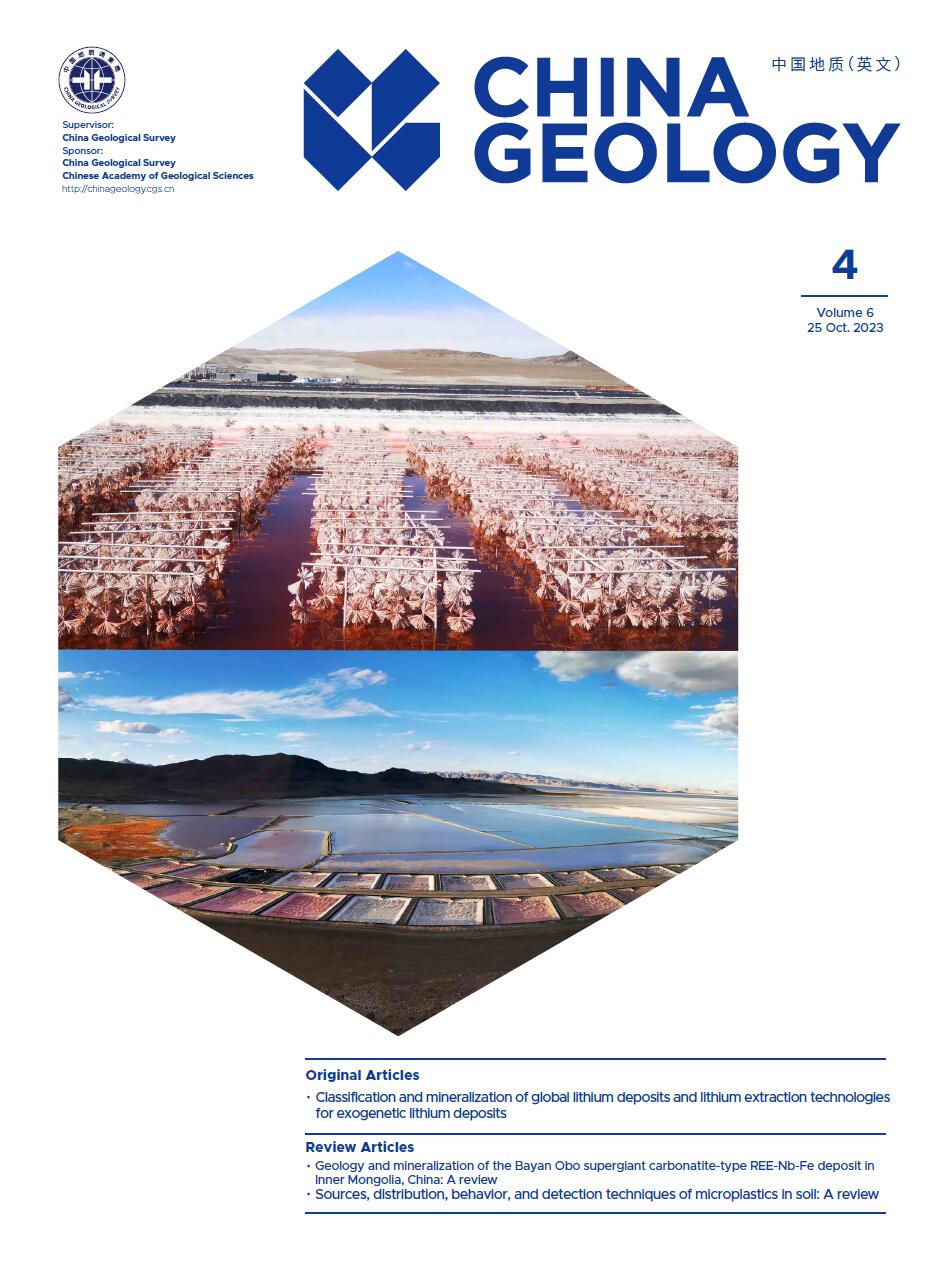



 DownLoad:
DownLoad:
